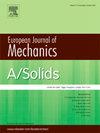Physics-informed deep neural networks towards finite strain homogenization of unidirectional soft composites
IF 4.2
2区 工程技术
Q1 MECHANICS
引用次数: 0
Abstract
The presence of heterogeneities and significant property mismatches in soft composites lead to complex behaviors that are challenging to model with conventional analytical or numerical homogenization techniques. The present work introduces a micromechanics-informed deep learning framework to characterize microscopic displacements and stress fields in soft composites with periodic microstructures undergoing finite deformation. The main obstacle we address is the construction of specific loss functions incorporating intricate knowledge of finite strain homogenization theory, which is valid for arbitrary macroscopic deformation gradients. Notably, a multi-network model is utilized to describe the discontinuities in material properties and solution fields within the composites. These neural networks communicate with each other through interface traction and displacement continuity conditions within the loss function. In addition, to exactly impose the periodicity boundary in hexagonal and square unit cells, the neural network architectures are modified by incorporating a number of trainable harmonic functions. A significant advantage of the current framework is that it allows for a straightforward solution of the governing partial differential equations expressed in terms of the first Piola-Kirchhoff stresses, eliminating the need for iterative formulations of the residual vector and tangent matrix required by classical numerical methods. We extensively assess the effectiveness of the proposed approach upon extensive comparison with isogeometric analysis to determine the displacement and Cauchy stress fields in square and hexagonal arrays of fibers/porosities, demonstrating neural networks as a powerful alternative to the conventional numerical approaches in finite deformation analysis of microstructural materials.
基于物理的单向软复合材料有限应变均匀化深度神经网络
软复合材料中存在的异质性和显著的性质不匹配导致了复杂的行为,这对传统的分析或数值均匀化技术来说是一个挑战。本研究引入了一种基于微观力学的深度学习框架,以表征具有周期性微观结构的有限变形软复合材料中的微观位移和应力场。我们解决的主要障碍是构建特定的损失函数,其中包含复杂的有限应变均匀化理论知识,该理论适用于任意宏观变形梯度。值得注意的是,利用多网络模型来描述复合材料中材料性能和溶液场的不连续性。这些神经网络通过损失函数内的界面牵引和位移连续性条件相互通信。此外,为了准确地在六边形和方形单元格中施加周期性边界,通过加入一些可训练的调和函数来修改神经网络架构。当前框架的一个显著优点是,它允许以第一Piola-Kirchhoff应力表示的控制偏微分方程的直接解,消除了传统数值方法所需的残差向量和切矩阵的迭代公式。通过与等几何分析的广泛比较,我们广泛评估了所提出方法的有效性,以确定正方形和六边形纤维/孔隙阵列中的位移和柯西应力场,证明神经网络是传统数值方法在微观结构材料有限变形分析中的强大替代方案。
本文章由计算机程序翻译,如有差异,请以英文原文为准。
求助全文
约1分钟内获得全文
求助全文
来源期刊
CiteScore
7.00
自引率
7.30%
发文量
275
审稿时长
48 days
期刊介绍:
The European Journal of Mechanics endash; A/Solids continues to publish articles in English in all areas of Solid Mechanics from the physical and mathematical basis to materials engineering, technological applications and methods of modern computational mechanics, both pure and applied research.

 求助内容:
求助内容: 应助结果提醒方式:
应助结果提醒方式:


